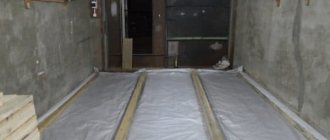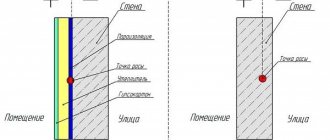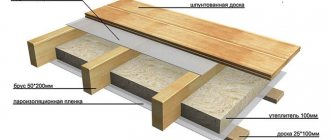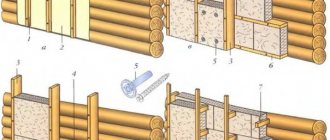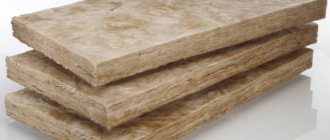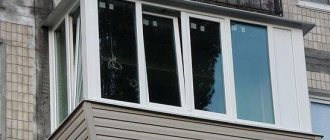One of the thermal insulation materials that is suitable for insulating a house yourself is ecowool. It is made on a cellulose basis, namely from wood fibers impregnated with brown and boric acid. Technological features of production make it possible to make the final insulation product wear-resistant, environmentally friendly, and energy efficient. When working, you can apply ecowool yourself. The structure of the substance ensures the necessary degree of filling the space of the treated surface. In view of these features, this type of thermal insulation should be considered in more detail.
Application methods
Cellulose wool has a loose composition. It contains grayish fibers. Cellulose insulation consists of 4/5 of used waste paper or newsprint and 1/5 of non-flammable substances that tend to reduce the likelihood of fire (usually borax and boric acid). The fibers are bonded together by lignin, which, when moistened, ensures reliable attachment of the composition to the surface being treated.
There are two methods by which ecowool is installed: wet and dry. They are used depending on the design features of the insulated surfaces. The dry method is different in that it does not require the use of a compressor.
The ability to evenly fill all the voids of frame buildings is an advantageous advantage of the dry technology of applying insulation, so during insulation work it is important to ensure the tightness and wind protection of the room. The insulation composition is supplied to the equipment hoses in a fluffy form. The process is not complicated, but requires compliance with a number of safety measures.
Cellulose insulation is suitable for insulating both internal and external walls, which makes this material universal.
There are two technological methods for installing thermal insulation:
- Blowing out. With this technique, the insulation composition is used to fill horizontal and inclined voids in frame walls. Thermal insulation is supplied through hoses through special holes in the wall. Ecowool fills the cavities inside, making insulation more effective.
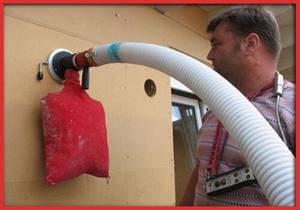
- Open laying. A method that allows you to quickly fill open horizontal areas with insulation. Floor insulation with ecowool is often done using this method. The thermal insulation product is distributed evenly over the surface to be treated using a pump hose.
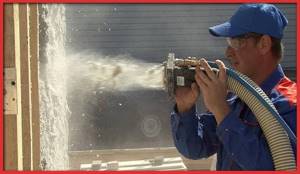
The wet method of applying ecowool is used when working on insulating external vertical sections and insulating interfloor ceilings. Roof insulation with ecowool can also be done using the wet application method. This technology differs from the dry method in the insulation composition. Dry raw materials are diluted with an adhesive or water base.
During installation, the need to carry out hydro- and vapor barrier measures in such places as:
- underground space;
- exterior walls;
- roof;
- ceilings between the attic and the lower floor.
Using special equipment for installation instead of manual installation will provide better thermal insulation, so hiring specialists to carry out the work will be the right decision. Organizations working in this area will provide prices for services that include both the cost of work and the cost of products. The consumption of ecowool can be assessed independently. It ranges from 40 to 65 kg per cubic meter depending on the surface. When applied horizontally, the consumption is minimal, when applied vertically – maximum.
Pros and cons of ecowool insulation
When considering ecowool as insulation for a house under construction, it is necessary to objectively weigh all its positive and negative aspects. The material is often presented by manufacturers as the best option for insulation. This is partly true - cellulose filler is among the top five insulation materials. However, the presence of problems when using this thermal insulator does not allow us to assign it the status of “ideal”.
Advantages
The main advantages of ecological wool are:
- The ability to absorb and evaporate moisture when humidity conditions change.
- Preservation of thermal insulation properties with partial adsorption of water.
- No seams or gaps that form “cold bridges”.
- Chemical inertness of the constituent ingredients.
- Optimal breathability at any thickness.
- Harmless to health due to the absence of harmful components.
- High sound insulation properties.
- Can be used over very large areas.
- Universal application (possibility of processing any surfaces).
- No waste when laying the material.
- Low market value compared to analogues.
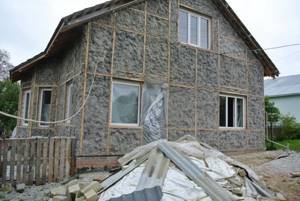
Disadvantages of thermal insulation
With all the stated advantages, it is necessary to take into account that over time ecowool partially loses its thermal insulation properties. This is explained by the fact that the insulation layer is saturated with moisture, which does not completely evaporate.
In order for wall insulation to be effective throughout its entire service life, it is necessary to ventilate and add extra material.
The second disadvantage of ecowool is shrinkage. This disadvantage manifests itself when walls are insulated. Vertical laying leads to gradual subsidence of the mass and the appearance of voids. To avoid this, it is necessary to install a denser layer.
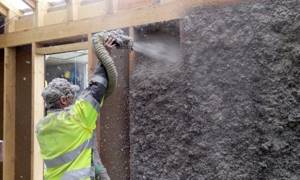
Another disadvantage of ecowool is caused by its reduced rigidity. If slab and roll insulation can be laid on a free surface, then wool requires a frame. Ecowool insulation is a complex technological process. Uniform and dense coating is possible only with the use of special equipment. The larger the area to be processed and the required thickness of insulation, the more powerful the technical device should be. Low financial costs for the material are covered by the wages of the construction team.
Some negative aspects are related to the specific installation method. This creates dust when applied dry. Wet application requires long-term drying of the thermal insulation layer (from 48 to 72 hours). This delays the construction process and delays further work on vapor barrier and finishing.
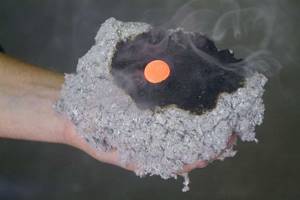
Preparation for insulation using the blowing method
Insulation of walls and ceilings using the blow-in method begins with preparation for this process. If you plan to do the thermal insulation work yourself, then you need to purchase all the necessary equipment, calculate the material and prepare the working surface. Knowing the consumption of the substance per cubic meter and the thickness of the walls, you can determine what the consumption of ecowool is per 1 square meter. m.
Calculating the amount of cellulose wool required for insulation is an important procedure. Mistakes at this stage will lead to unnecessary costs for raw materials.
The consumption of ecowool per square meter of walls and ceilings varies, which must be taken into account when calculating the amount of ecowool required for work. Ecowool is transported in bags. One bag contains 0.14 cubic meters or, in terms of weight, 15 kg of thermal insulation composition. For a house with a base area of 60 m2, with an ecowool consumption of 50 kg per m2, you will need about a hundred of these bags. The amount of insulation depends on the thickness of the walls or floor slabs.
Wet method
Applying ecowool using a wet method is difficult to do with your own hands. Wet insulation is carried out only using expensive equipment. In a private home, the volumes are not so large that it would be economically profitable to carry out such work yourself.
The technology of laying ecowool using the wet method is applicable for thermal insulation work on the facade or under the roofing. On the facade, the technique is applicable only if finishing is possible. To supply wet adhesive-based composition, equipment with special nozzles is used to ensure uninterrupted supply of the composition under pressure. Drying time for insulation is 12 hours. Ecowool consumption when using the wet application method is 70-75 kg per square meter.

Due to its characteristics, ecowool eliminates the possibility of deformation of the thermal insulator during installation using the wet method. Condensation does not accumulate in the walls. Removal of excess material is done in a simple way - with a scraper and hands. After drying, the thermal insulation is hidden in the body of the wall with finishing materials.
Insulating the ceiling with ecowool using the wet application method will save time. Installation of insulation is carried out after installing a vapor barrier. Traditional methods of ceiling insulation are inferior to this method for several reasons. When insulating with ecowool, there are no microgaps between the main structures of the building and the insulation. In a wooden house, the wet application method can also be used to insulate the floor with ecowool.
Areas of use of the material
Ecowool is a universal insulation material, which allows it to be used for insulating country houses, private houses, multi-storey residential and public buildings, industrial buildings, for arranging warehouses and retail outlets, as thermal insulation for saunas, baths and swimming pools. Due to its excellent soundproofing properties, this material is used in the arrangement of acoustic rooms and recording studios.
Evgeniy Filimonov
Ask a Question
When insulating the walls of a house, dry and wet installation methods can be used. The attic, floors and roof are insulated using manual dry installation of insulation.
To reduce heat loss in the attic, two methods of thermal insulation can be used: dry blowing of the walls with special equipment and manual laying of the material on the floor.
Dry plaster mixtures can be made on the basis of ecowool, which can be used to treat concrete, brick and gas silicate walls to improve their sound and heat insulation characteristics.
Dry method
The dry method is also applicable for insulating ecowool walls on the indoor and outdoor sides. As a rule, it is used when necessary to fill the voids in the walls of frame houses. Insulating the roof with ecowool using a dry method is also possible, but only if there is a frame to fill it with heat-insulating material. Ecowool consumption with this method is 10-15% more economical than when applying insulation using the wet method.
Before you start applying insulation, you need to prepare it. The raw materials arrive in pressed form, so it will be impossible to apply ecowool in a commercial form. Modern equipment has the function of fluffing raw materials with a built-in mixer, but if this is not available, then the composition will need to be fluffed manually. Subsequently, under the influence of high air pressure in the hose, the composition will reach the required state. The degree of “fluffiness” of the raw material affects the penetration of insulation into all corners of the cavity, providing maximum coverage.

Dry and wet method of ecowool insulation
The dry method of installing the insulating layer is more universal. It is not necessary to form closed cavities on horizontal surfaces to fill them with insulation. You can tightly lay (fall asleep, blow out) ecowool between the joists, then sew it up with a subfloor.
A layer of cellulose fiber insulation on the attic floor (if the cold attic is not in use) is sometimes simply left unprotected after installation, or covered with a wind barrier. For inspections, it is enough to throw a board between the beams. This layer can be easily corrected with a simple shovel or broom. Independent insulation with ecowool using this simple method is complicated only by the need to lift bags with insulation to the top, unpack them, and loosen the insulation.
Mechanical laying of dry ecowool using blowing equipment allows you to avoid heavy physical labor, dirt, and dust. Significantly reduces the period of insulation. In addition, ecowool supplied under pressure fills all the cracks and joints and lays much more densely than with manual laying.
The wet-adhesive method of installing ecowool is more often used to increase the thermal insulation properties of open vertical wall structures. The ecowool stream is slightly moistened at the outlet of the hose and glued to a vertical plane.
Moistened ecowool adheres to the surface, forming a monolithic layer with it. The adhesion and mechanical strength of the dried layer is determined to a greater extent by natural lignin than by minor additions to the PVA glue water.
Digression: Lignin is a natural polymer found in plant tissue that provides adhesion to cellulose fibers and their protection in wood and other plants. After the moistened layer begins to dry out, a dense crust forms on the outer surface. Internal connections are also formed within the layer. This principle is used to make papier-mâché crafts. It has also found its application in thermal insulation work.
How to lay insulation manually
If you want to save on installation work to insulate your home, you can apply the insulation yourself. Do-it-yourself ecowool takes a lot of time to install. Blowing in the wall ensures greater density of insulation and filling of cavities with ecowool. When laying insulation manually, the consumption of ecowool is correspondingly reduced.
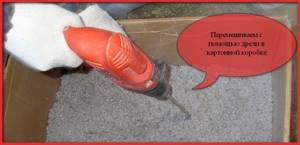
Before direct application, the insulation is laid out from the bags into a specially prepared trough, after which it is mixed with a mixer to give the material the required density and consistency. To do this, you will need to purchase a construction mixer or drill with a suitable attachment. Thermal insulation should be installed using personal protective equipment to protect the respiratory tract and mucous membranes of the eyes from dust.
Installation equipment
If insulation is not done manually, then you should purchase the necessary equipment for installing ecowool. The installation for blowing ecowool is assembled on the basis of a vacuum cleaner. If necessary, you can assemble the entire blowing device for ecowool with your own hands. A detailed list of what equipment is needed for applying ecowool is given below:
- Vacuum cleaner Elitech BC 2000 power 2 kW/
- An electric drill or construction mixer with an attachment for mixing paint or dry mixtures.
- Container for mixing insulation raw materials 200 liters.
- Corrugated pipe for electrical cables with a diameter of 63 mm.
- Special electric roller scissors for trimming excess insulation
- Roll of tape.
Homemade equipment for blowing ecowool
Since professional equipment for working with ecowool costs a lot of money, craftsmen have come up with several substitutes. Here is a description of the most popular of these devices:
Things you need to stock up on in advance:
- In addition to ecowool, a mandatory component is a 2000-watt garden vacuum cleaner with the ability to regulate speed. Should provide air flow speed in the region of 170-250 km/h. You will have to spend around 3,000 rubles to purchase it;
- 7 m corrugated wires. It should have a diameter of 63 mm;
- Drill and mixing attachment for it;
Sequence of work:
- One part of the vacuum cleaner proboscis must be disconnected and the terminals must be moved to the main base. Due to this, the suction power will be increased.
- To prevent ecowool from clogging into the pipe that leads to the dust collector, it is necessary to remove the teeth that are located in this pipe. This is done with the help of wire cutters. Care must be taken, otherwise the plastic of the case may be damaged.
- After the teeth are removed, it is necessary to attach a corrugation with a diameter of 63 mm to the opening of the dust collector. Complete removal of the teeth ensures a smooth entry of the tube. You can secure it with tape.
- To prevent dust from flying to the sides during blowing, you can make an o-ring. The material for it can be cloth - we wrap it around the corrugation and press it against the wall while working.
- After completing all these steps, you will already have a device for ecowool. In order to start direct work, you need to find one assistant.
How the insulation works:
- To insulate and insulate the walls, you need to make holes of about 70 mm in their upper part. The distance from the ceiling should be 7-10 cm.
- We fill half of the construction trough with ecowool.
- We begin to stir the ecowool using a mixing attachment. This must be done until it rises to the brim.
- A corrugation is lowered into the hole in the wall. Once with a marker, mark a section of the pipe approximately 30 cm from the floor (it is to this level that the corrugation must be lowered each time).
- The next stage will require coordinated work of 2 people. One person uses a fabric gasket to seal the gap and hold the corrugation as close to the hole as possible.
- The second includes a self-made device for blowing out ecowool. Third or fourth speed is required. In this case, material is gradually removed from the container.
- When the cotton wool reaches the hose, you need to lift it 50 cm and clamp it with a gasket. Repeat this process until 1 cm of corrugation remains in the hole. The remaining cavities must be filled to the maximum. This is the final part of the insulation.
If you need to spray ecowool on the floor, the method described above will not work. Because There are no closed cavities on the floor, and the cotton wool will be blown away from it.
Ecowool: do-it-yourself insulation
When preparing to independently insulate a house with ecowool, you can use a kind of calculator to calculate the needs for cellulose wool, based on consumption data for each section of the building structure. The table below shows data on insulation consumption when insulating roofs, walls, and ceilings with ecowool. The table shows data on insulating structures of various thicknesses with insulation.
| Installation location Layer thickness | 50 mm | 75 mm | 100 mm | 150 mm |
| Horizontal designs | 2 kg | 3 kg | 4 kg | 6 kg |
| Vertical and inclined structures | — | 4.13 kg | 5.5 kg | 6 kg |
| Wet, wet-adhesive application | 3.5 kg | 5.35 kg | 7 kg | 10.5 kg |
The total volume of material is calculated by multiplying the surface quadrature by the consumption per 1 sq. m. It is important to take a reserve of 10% for unforeseen expenses. The area of the walls is calculated by multiplying the perimeter of the room by the height of the ceilings minus the area of window and door openings.
Description of insulation
Using ecowool to insulate a private home allows you to provide the building with the necessary thermal protection, guaranteeing warmth and comfort in the winter season. Insulation with ecowool is not particularly difficult, so most homeowners will be able to carry out repair work themselves, saving on the services of professional builders.
Ecowool is a loose thermal insulation material that consists of 90% cellulose and includes various antiseptic components and fire retardants. Due to the mineral salt contained in ecowool, it has excellent antifungal and antiseptic properties. Good performance characteristics are largely ensured due to the presence of cellulose in the insulation, which is an environmentally friendly material that is resistant to moisture and fire.
Ecowool is produced using a special technology by processing waste paper with waste from the paper industry.
The use of completely natural ingredients ensures that this material is completely environmentally friendly and completely safe for humans. Due to its porous, loose structure, the insulator provides excellent insulation of the house and is an excellent alternative to insulation materials such as polystyrene foam and mineral wool. The excellent efficiency of this heat insulator and the versatility of its use make it possible to insulate houses with ecowool in private buildings built from wood, brick and foam blocks. Thanks to the affordable cost of ecowool and the ability to do all the work yourself, the homeowner’s home renovation costs are significantly reduced.
Ecowool or penoizol
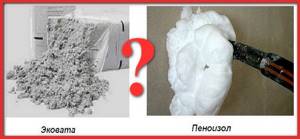
Among insulation products there are several products that do not form seams during installation. Many people ask themselves what is better: ecowool or penoizol. Both substances have many advantages. However, it is worth noting that the first of them is a truly natural material made from wood. In addition, this insulation helps in the fight against rodents. Boric acid repels many pests, which is very important for residents of private homes. Penoizol has one drawback - when applied, it releases formaldehydes that are harmful to humans, which can also be released during a fire. But the right to choose still remains with the buyer.
What are the advantages of cellulose wool? Its components are low-toxic: antiseptic and antispirin are characterized by moderate harm to health. Eco-friendly cotton wool does not rot, does not burn in fire, and has high heat and sound insulation. It is capable of concentrating in the upper layers of the composition and retaining up to 20% moisture, which does not affect the consumer properties of the product. Without contacting substances on the surface, cellulose insulation does not corrode.
